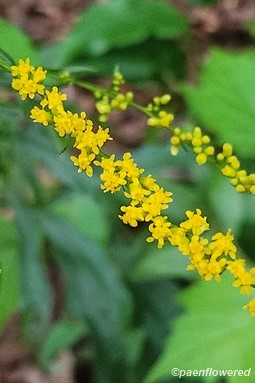Solidago juncea
Solidago juncea early goldenrod
There are about 30 different native goldenrod species that bloom during the summer and fall in our state. Many of them look much alike except for fine details of their flowers, stems and leaves. Distinguishing them can be a challenge. The early goldenrod is notable and most easily identified because it is the first one to bloom, usually appearing in early to late July. Blooming date will depend on the temperature and rainfall earlier in the summer.
Many people blame goldenrods for summer nasal allergies, but it is not guilty. It is insect pollinated and thus has pollen that is heavy and sticky, and very unlikely to blow in the wind and enter your nasal passage. Summer and autumn allergies are usually due to grasses and ragweed. You should thus enjoy the colorful show of these summer and fall native wildflowers.
This species grows 1 ½ to 4 feet tall, smaller than some of the later blooming species. Like other goldenrods it is a member of the aster family. It is generally found in dry soil along roadsides, fields, rocky banks and open woods throughout central and eastern United States. It produces showy arching plumes of golden yellow flowers at the top of the plant. Each tiny individual flower is ¼ inch in diameter and is composite consisting of 7-12 petal-like ray flowers. These flowers will persist for some time, attracting a wide variety of insects as pollinators. When the seeds form, they will be dispersed by the wind on tufts of hair. Most goldenrods are drought tolerant.
This species is noted for its generally hairless condition, and the presence of wing-like leaflets where the thin upper opposite toothless leaves meet the main stem. These small leaves are the easiest distinguishing traits to notice. It is also one of those goldenrod species that has parallel rather than netted leaf veins.
Habitat & Range
Grows in field, meadows, along roadsides and on rocky slopes.
Present throughout the state.
Wetland code: Not classified
Phenology
Flowers early July to October.
Plant Codes
S-rank: No rank
G-rank: G5 (Secure)















Comments
Have you spotted this plant in your area? We'd love to hear about your experience! Share your comments or questions about the plant below. Comments are moderated before posting.